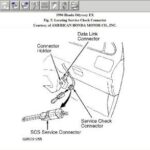Determining whether your 1995 Ford F150 uses OBD1 or OBD2 diagnostic systems is a common question for owners. While OBD2 was becoming the standard around this time, the 1995 F150, particularly models produced earlier in the year, typically utilizes the older OBD1 system. This means reading your check engine light codes requires a slightly different approach than modern vehicles. Forget scanning tools for now; you can diagnose your 95 F150 right in your garage with just a simple piece of wire and your vehicle’s check engine light. This guide will walk you through the process of retrieving these codes yourself.
Is My 1995 F150 OBD1 or OBD2?
For the 1995 model year, the Ford F150 is generally equipped with an OBD1 diagnostic system. OBD2 became mandatory in 1996, so your ’95 truck falls into the OBD1 era. This distinction is crucial because the diagnostic connectors and code reading methods are different between the two systems. Therefore, understanding that your 1995 F150 is likely OBD1 is the first step in correctly diagnosing any engine issues indicated by your check engine light.
How to Read OBD1 Codes on a 1995 F150
Reading OBD1 codes on your 1995 F150 is a straightforward process that involves using a jumper wire to bridge specific terminals on your vehicle’s diagnostic connector. This initiates a diagnostic mode where the check engine light flashes in patterns to communicate error codes. Here’s how to do it:
Locate the EEC Connector
First, pop the hood of your F150. Locate the EEC (Electronic Engine Control) connector. It’s usually found on the driver’s side fender well, near the firewall. Look for a black, oblong connector that is not connected to anything. It’s often secured in a protective plastic clip. Unclip this connector from its plastic holder. You’ll also notice a small, single gray connector nearby, also in the same protective plastic piece – unclip this one as well.
Prepare to Read Codes
Now, take a piece of wire – any standard insulated wire will work. You’ll use this as a jumper to connect two specific points in the diagnostic system.
Perform the KOEO Test
With the engine OFF and the ignition key in the OFF position, locate the larger EEC connector with six terminals. Orient the connector so that the row of four terminals is at the bottom and the row of two terminals is at the top. Insert one end of your jumper wire into the top right terminal (the rightmost terminal in the two-terminal row). Connect the other end of the jumper wire to the single gray connector you located earlier.
Now, turn the ignition key to the RUN position – do not start the engine. Observe the check engine light. It will begin to flash a series of codes.
Reading the Codes
The check engine light will flash in a sequence to represent the diagnostic trouble codes (DTCs). Codes are communicated in a two-digit format. For example, code 21 will be flashed as two quick flashes, a short pause, then one quick flash. There is a slightly longer pause between digits of a code, and a longer pause between complete codes. Pay close attention and write down the flashes.
Let’s break down how to interpret a code like 212:
- Flash, pause, flash, flash (represents “2”)
- Longer pause
- Flash (represents “1”)
- Longer pause
- Flash, flash (represents “2”)
- Longer pause (between codes)
There will be a 4-second pause between each code. After all KOEO (Key On Engine Off) codes are displayed, there will be a 6-second pause, followed by a single flash, and another 6-second pause, signaling the end of the KOEO codes. Following the KOEO codes, “Continuous Codes” (also known as CM codes or memory codes) may be displayed in the same flashing pattern. These represent codes stored in memory from previous driving cycles.
Clearing the Codes
If you wish to clear the stored codes after diagnosing and repairing the issue, simply disconnect the jumper wire while the test is running. This will reset the system memory and clear the codes.
By following these steps, you can effectively read the OBD1 trouble codes on your 1995 Ford F150 without needing a scan tool. This DIY method can save you time and provide valuable insights into your vehicle’s health, empowering you to address any issues promptly.
